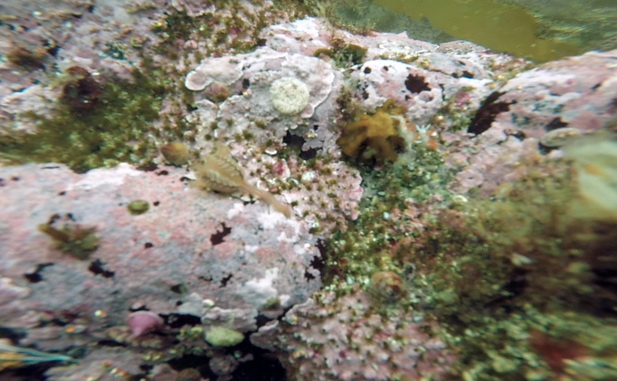Herring-bone stalked jelly • Manania distincta
Identification
This species of stalked jellyfish (Order: Stauromedusae) can grow to 5 cm in height, and is identified by the dark herringbone pattern on its funnel shaped body (calyx). Unlike most other jellyfish that swim freely at some stage in their life cycle, this species (along with other stalked jellyfish) spends its entire life attached to the substrate.
Habitat and Range
Herring-bone stalked jellyfish are fairly uncommon, and prefer areas where wave action and surges are stronger. This species’ range includes exposed, outer shorelines from northern Alaska south to Oregon. It can also be found off the coast of Japan and Siberia.
Similar Species
Several other species of stalked jellyfish can be found on the BC's Central Coast. Manania gwilliami (red stalked jelly) also prefers habitats with higher wave action, however this species is red in colour, and thus is not easily confused with the herring-bone stalked jellyfish. The stalk of Haliclystus stejnegeri (oval-anchored stalked jelly) splits into 8 brush-like arms with ends tipped with anchors and fringed by tentacles. H. stejnegeri also has variable colouration, and can be orange, yellowish, brown, or greenish. Manania handi (windowed stalked jelly) is bright green and usually camouflaged in eelgrass (Zostera marina) beds in southern British Columbia and Washington State.
This species of stalked jellyfish (Order: Stauromedusae) can grow to 5 cm in height, and is identified by the dark herringbone pattern on its funnel shaped body (calyx). Unlike most other jellyfish that swim freely at some stage in their life cycle, this species (along with other stalked jellyfish) spends its entire life attached to the substrate.
Habitat and Range
Herring-bone stalked jellyfish are fairly uncommon, and prefer areas where wave action and surges are stronger. This species’ range includes exposed, outer shorelines from northern Alaska south to Oregon. It can also be found off the coast of Japan and Siberia.
Similar Species
Several other species of stalked jellyfish can be found on the BC's Central Coast. Manania gwilliami (red stalked jelly) also prefers habitats with higher wave action, however this species is red in colour, and thus is not easily confused with the herring-bone stalked jellyfish. The stalk of Haliclystus stejnegeri (oval-anchored stalked jelly) splits into 8 brush-like arms with ends tipped with anchors and fringed by tentacles. H. stejnegeri also has variable colouration, and can be orange, yellowish, brown, or greenish. Manania handi (windowed stalked jelly) is bright green and usually camouflaged in eelgrass (Zostera marina) beds in southern British Columbia and Washington State.
References
Lamb, A., and Hanby, B. (2005). Marine Life of the Pacific Northwest [electronic version]. Madeira Park, BC: Harbour Publishing.
Martellos, Stefano, Luca Ukosich, and Massimo Avian. "JellyWeb: an interactive information system on Scyphozoa, Cubozoa and Staurozoa." ZooKeys 554 (2016): 1
Authors and editors of page
Bea Proudfoot and Kelly Fretwell (2016)
Lamb, A., and Hanby, B. (2005). Marine Life of the Pacific Northwest [electronic version]. Madeira Park, BC: Harbour Publishing.
Martellos, Stefano, Luca Ukosich, and Massimo Avian. "JellyWeb: an interactive information system on Scyphozoa, Cubozoa and Staurozoa." ZooKeys 554 (2016): 1
Authors and editors of page
Bea Proudfoot and Kelly Fretwell (2016)




